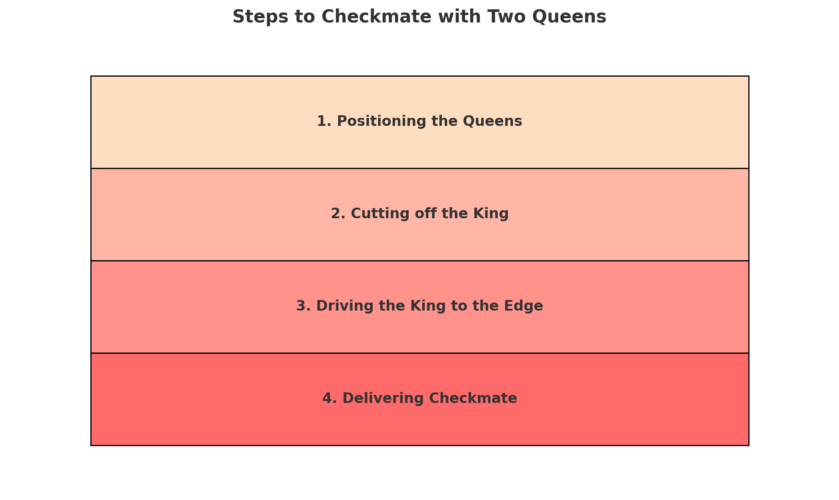How to Checkmate with 2 Queens: An Expert’s Guide
Chess, an ancient game of strategy and intellect, is all about understanding the power of each piece and leveraging it to win. One of the most sought-after situations in the game is achieving a checkmate, a position where the opponent’s king is under direct threat and cannot escape capture. Now, imagine having not one, but two queens on the board – the epitome of chess dominance!
But how often do we encounter such a situation? Surprisingly, promoting a pawn and having two queens isn’t as rare as one might think. This guide delves deep into using these two powerful pieces to declare a resounding checkmate.
Whether you’re a budding enthusiast or a seasoned player, this expert guide will provide you with insights that are bound to elevate your game. Read on to unravel the mastery of checkmating with two queens, and prepare to leave your opponents in awe.
Understanding the Power of Two Queens
The queen, often referred to as the powerhouse of the chessboard, possesses an unmatched combination of power and mobility. When two queens join forces, they can control a vast majority of the board, making the opponent’s defense extremely challenging.
Power and Mobility of Queens on the Board
- Range: Unlike other pieces, a queen can move any number of squares along a rank, file, or diagonal. This incredible range allows her to exert pressure on distant parts of the board while staying safe.
- Flexibility: The queen combines the strength of both the rook and bishop. No matter where she stands, she can swiftly change the course of the game.
- Control: A single queen can control up to 27 squares from the center of the board. Imagine the dominance with two!
For a more in-depth understanding of the queen’s prowess and her comparison to other pieces, dive into our comprehensive guide on what chess pieces represent.
The Importance and Effectiveness of Two Queens
- Double the Threat: With two queens, you can threaten multiple pieces simultaneously, often forcing the opponent to make undesirable trades or moves.
- Versatility: While one queen keeps the enemy king in check, the other can focus on capturing other pieces or controlling critical squares.
- Defense and Offense: In situations where defense is crucial, one queen can protect essential pieces or squares while the other goes on the offensive.
The power of two queens is reminiscent of the importance of having a good pawn strategy. Just as pawns can be promoted to queens, mastering pawn tactics can dramatically influence the game.
Scenarios Where a Player Can Have Two Queens
- Pawn Promotion: The most common scenario is promoting a pawn. Once a pawn reaches the opposite end of the board, it can be upgraded to any piece. Naturally, players often choose the queen for her unmatched power. Our guide on pawn structure basics is a must-read to understand pawn promotion and its strategies.
- Recovery: In rare cases, if a queen is captured early in the game and a pawn is subsequently promoted, a player can have two queens.
How to Checkmate with Two Queens
Having two queens on the board is like having two aces up your sleeve. Yet, their power is futile if not used efficiently. The technique of checkmating with two queens is artful, systematic, and remarkably effective.
The Basic Strategy
- Board Control: With two queens, the board is virtually yours. The first step is to ensure both queens are positioned to restrict the opponent’s king’s movements.
- Coordination: Both queens should work in tandem, covering each other’s weaknesses and making sure there are no gaps in your strategy.
- Pressure: Consistently put the opponent’s king under threat. This forces them to make moves they otherwise wouldn’t, leading them into a trap.

For beginners trying to grasp the essence of this strategy, a quick refresher on chess tips for beginners can be enlightening.
Dividing the Board into a “Virtual Rectangle”
- Visualization: Imagine the board is segmented into a rectangle, with the enemy king inside it. This rectangle is the area the king can move within.
- Restriction: Use your queens to restrict this rectangle, ensuring the king remains confined within it. The technique is similar to herding a sheep into a pen.
Gradual Shrinking of the Rectangle
- Tightening the Noose: Every move should aim to reduce the size of the virtual rectangle, limiting the king’s mobility.
- Consistency: Ensure that with each move, the confinement becomes stricter. Any lapse can allow the king to escape, prolonging the game.
Utilizing the Staircase Method
- Sequential Moves: Once the king is near the edge of the board, use the queens in a sequential manner to force the king towards a corner, forming a staircase pattern.
- Final Blow: When the king is in the corner and has no legal moves left, deliver the checkmate.
This technique, although seemingly simple, requires practice and precision. If you’re a budding chess enthusiast, understanding basic chess rules can provide a solid foundation, making mastering techniques like this one smoother.
Armed with this strategy, the “How to Checkmate with 2 Queens” technique becomes an invaluable tool in your chess arsenal. However, as with all things chess, practice is key. Dive deeper, explore more, and let the queens reign supreme.
Detailed Steps to Checkmate with Two Queens
Achieving a checkmate with two queens is akin to a choreographed dance, where both queens move in harmony to corner the enemy king. Here’s a step-by-step guide to ensure your queens’ duet results in a flawless checkmate.
Step-by-Step Guide:
- Positioning the Queens: Start by placing one queen a knight’s move away from the opponent’s king. This ensures the king cannot capture the queen while being under threat.
- Securing the Territory: Move the second queen parallel to the first, ensuring they’re covering each other. This move confines the king further, restricting its mobility.
- Shrinking the Space: Each subsequent move should aim to limit the king’s available squares, gradually pushing it to the board’s edge.
- Cornering the King: Once the king is forced to the edge, use the queens in tandem to push it to a corner, setting up for the final checkmate.
Careful Considerations, Common Mistakes, and Solutions:
- Avoid Stalemates: One of the most common mistakes is unintentionally causing a stalemate by leaving the king with no legal moves but not in check. Always ensure the king has an escape square until the final move.
- Protecting the Queens: While the queens are powerful, they aren’t invincible. Ensure they always protect each other to prevent any surprise captures by the opponent’s remaining pieces.
- Time Management: For those playing timed games, it’s crucial not to rush. While two queens are dominant, hastily moving can lead to errors. To master time management in chess, our guide on using the analog clock in chess is invaluable.
- Avoid Repetition: Ensure you’re not repeating moves, which can lead to a draw. Continually work towards shrinking the king’s available space.
To avoid common pitfalls, new players might benefit from revisiting basic chess rules. Sometimes, revisiting the basics helps in mastering advanced techniques.
Tips and Tricks while Checkmating with Two Queens
Achieving checkmate with two queens is an exhilarating experience, but it requires finesse, precision, and strategy. While the basic steps to checkmate are crucial, mastering the nuances ensures you can achieve victory in fewer moves, and with style. Let’s delve into the expert tips and tricks to enhance your dual-queen checkmating skills.
Tips and Tricks while Checkmating with Two Queens
- Control the Center: Always aim to control the board’s center with your queens. This gives you the flexibility to maneuver and chase the king effectively.
- Use the ‘Shadow Technique’: Keep the queens in a configuration where they ‘shadow’ each other, ensuring they’re safe from any sudden king attacks.
- Minimize King’s Options: With every move, focus on reducing the squares available to the king. The more you limit its mobility, the quicker you’ll achieve checkmate.
For those looking to refine their overall gameplay, our chess tips for beginners offers invaluable insights.
Commonly Overlooked Strategies
- Dual Threats: While the primary goal is to checkmate the king, don’t forget to create dual threats. For example, threatening another piece while also cornering the king can force your opponent into undesirable moves.
- The Power of Zugzwang: In certain positions, forcing the opponent to move can be to their disadvantage. Use your queens to create situations where any move the opponent makes worsens their position.
- Flexible Adaptation: If you notice the current strategy isn’t working or it’s taking too many moves, be ready to adapt. Sometimes, repositioning a queen can make the process more efficient.
To understand the nuances of each piece and its strategic value, our guide on what chess pieces represent is a must-read.
Advice to Avoid Stalemates
- Always Give an Escape: Until you’re ready for the final checkmate move, ensure the king has at least one square to move to.
- Watch for Traps: Be cautious not to get so focused on the king that you overlook potential stalemate situations involving other pieces.
- Practice Scenarios: Regularly practice endgame scenarios with two queens against a king. The more you practice, the more familiar you become with potential stalemate situations and how to avoid them.
Stalemates can be frustrating, especially when you have a dominant position. To avoid such pitfalls and master the art of checkmating, revisiting basic chess rules can be immensely beneficial.
Conclusion and Additional Resources
Navigating the intricate world of chess, particularly mastering the technique of “How to Checkmate with Two Queens,” is a journey of strategic prowess and analytical acumen. Harnessing the power of two queens to corner and checkmate an opponent’s king is both an art and a science. We’ve explored the foundational strategies, delved into nuanced tactics, and highlighted potential pitfalls to avoid.
For those eager to elevate their game further:
- Dive into our comprehensive chess tips for beginners to solidify your foundational knowledge.
- Explore the basic chess rules to ensure you’re well-acquainted with every aspect of the game.
- Expand your strategic horizon by understanding the importance of pieces through what chess pieces represent.
Chess is a game of endless possibilities and strategies. While mastering the technique of checkmating with two queens is a significant achievement, it’s just one of many strategies to learn and perfect.
Keep practicing, stay curious, and may your queens always reign supreme on the board.
FAQs
1. Is it possible to have two queens in a chess game?
- Yes, it’s possible. While each player starts with one queen, a pawn can be promoted to any piece (including a queen) when it reaches the opposite end of the board. Therefore, it’s possible for a player to have two or even more queens simultaneously.
2. How many moves does it typically take to checkmate with two queens?
- With optimal play, a player can checkmate the opponent’s lone king using two queens within a few moves, usually four to six. The exact number depends on the starting positions of the kings and queens.
3. Can I checkmate with just one queen?
- Absolutely! A single queen, with the support of her king, can checkmate an opponent’s lone king. However, having two queens speeds up the process and offers more flexibility in strategy.
4. What are the common mistakes to avoid when trying to checkmate with two queens?
- The most common mistake is causing a stalemate, where the opponent’s king has no legal moves but isn’t in check. Another error is not using the queens in coordination, allowing the opponent’s king to escape or prolong the game.
5. Are there other pieces with which I can achieve a checkmate?
- Yes, there are various combinations of pieces with which you can checkmate an opponent’s king, such as two rooks, a rook and a bishop, or a rook and a knight. Each combination has its own set of strategies and techniques.






